Leadership Strategies for Managing Millennials in the Modern Workplace
VerifiedAdded on 2022/11/24
|8
|1780
|438
Report
AI Summary
This report provides an overview of leadership styles and their relevance in managing people, with a specific focus on millennials in the workplace. The report begins by defining leadership and exploring different leadership styles, including autocratic, authoritative, democratic, and coaching styles. It then delves into the nature of millennials, highlighting their unique characteristics, expectations, and challenges they pose to traditional leadership approaches. The main body of the report discusses the challenges leaders face when dealing with millennials, emphasizing the importance of communication and building relationships. It then explores the most suitable leadership styles for millennials, concluding that the democratic style aligns best with their values and preferences. The report's conclusion summarizes key findings and emphasizes the importance of adapting leadership strategies to effectively manage people and systems, particularly in the context of a changing workforce. The report references various books and journals to support its arguments.
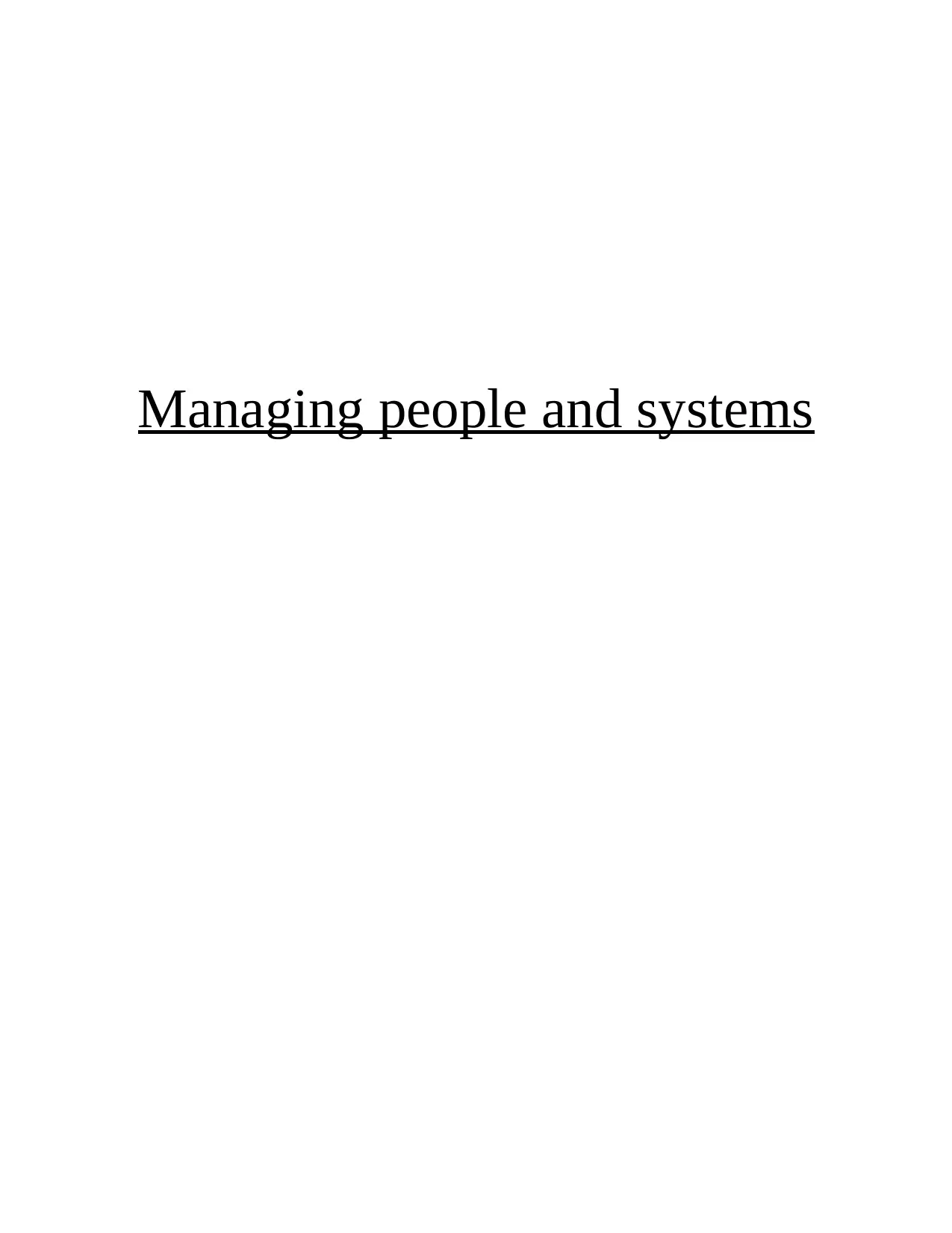
Managing people and systems
Paraphrase This Document
Need a fresh take? Get an instant paraphrase of this document with our AI Paraphraser
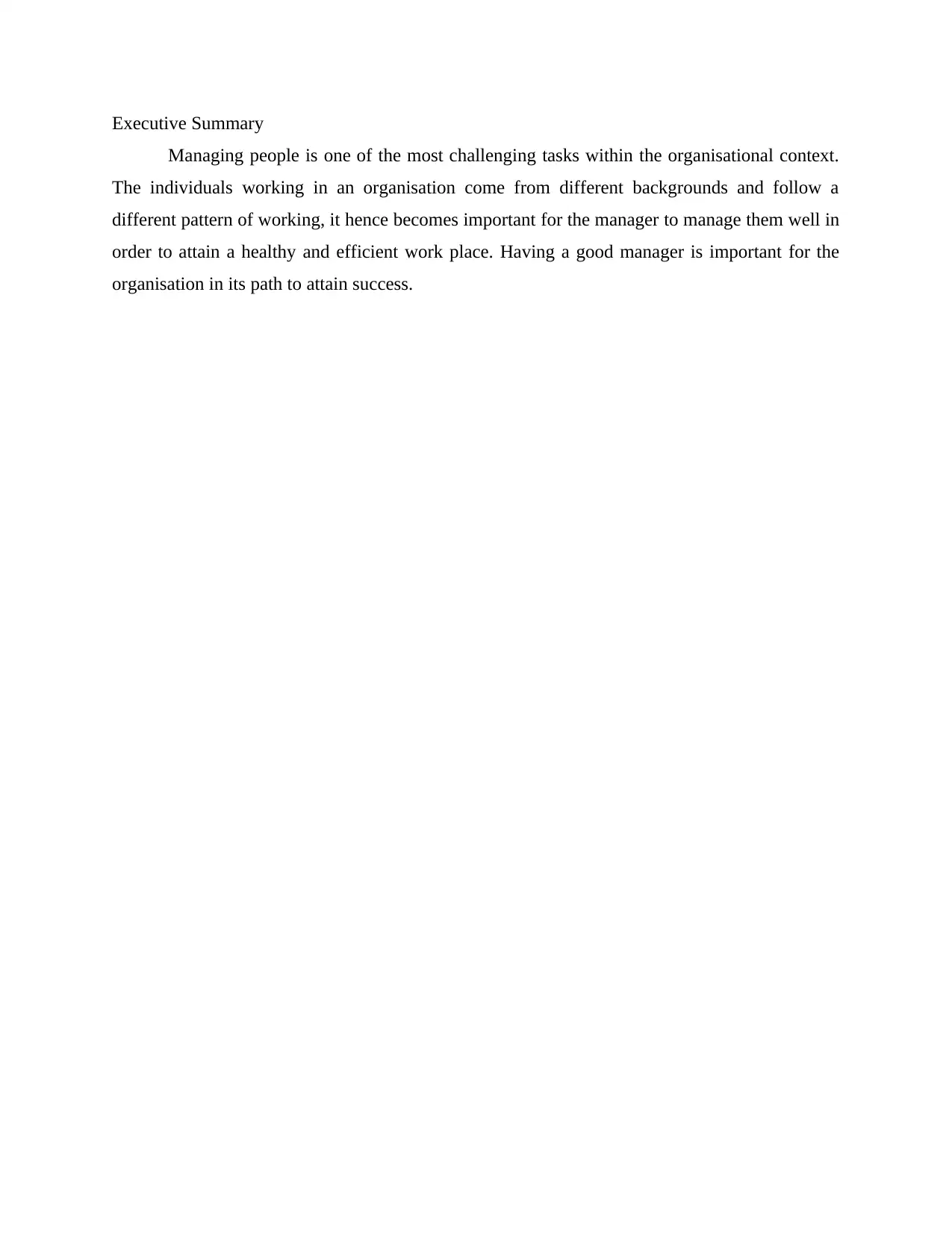
Executive Summary
Managing people is one of the most challenging tasks within the organisational context.
The individuals working in an organisation come from different backgrounds and follow a
different pattern of working, it hence becomes important for the manager to manage them well in
order to attain a healthy and efficient work place. Having a good manager is important for the
organisation in its path to attain success.
Managing people is one of the most challenging tasks within the organisational context.
The individuals working in an organisation come from different backgrounds and follow a
different pattern of working, it hence becomes important for the manager to manage them well in
order to attain a healthy and efficient work place. Having a good manager is important for the
organisation in its path to attain success.

TABLE OF CONTENTS
INTRODUCTION...........................................................................................................................4
MAIN BODY...................................................................................................................................4
Leadership....................................................................................................................................4
Different styles of leadership.......................................................................................................4
Nature of millennials....................................................................................................................5
Challenges faced by leaders when dealing with millennials.......................................................6
Leadership style for millennials...................................................................................................6
CONCLUSION................................................................................................................................7
REFERENCES................................................................................................................................8
INTRODUCTION...........................................................................................................................4
MAIN BODY...................................................................................................................................4
Leadership....................................................................................................................................4
Different styles of leadership.......................................................................................................4
Nature of millennials....................................................................................................................5
Challenges faced by leaders when dealing with millennials.......................................................6
Leadership style for millennials...................................................................................................6
CONCLUSION................................................................................................................................7
REFERENCES................................................................................................................................8
⊘ This is a preview!⊘
Do you want full access?
Subscribe today to unlock all pages.

Trusted by 1+ million students worldwide
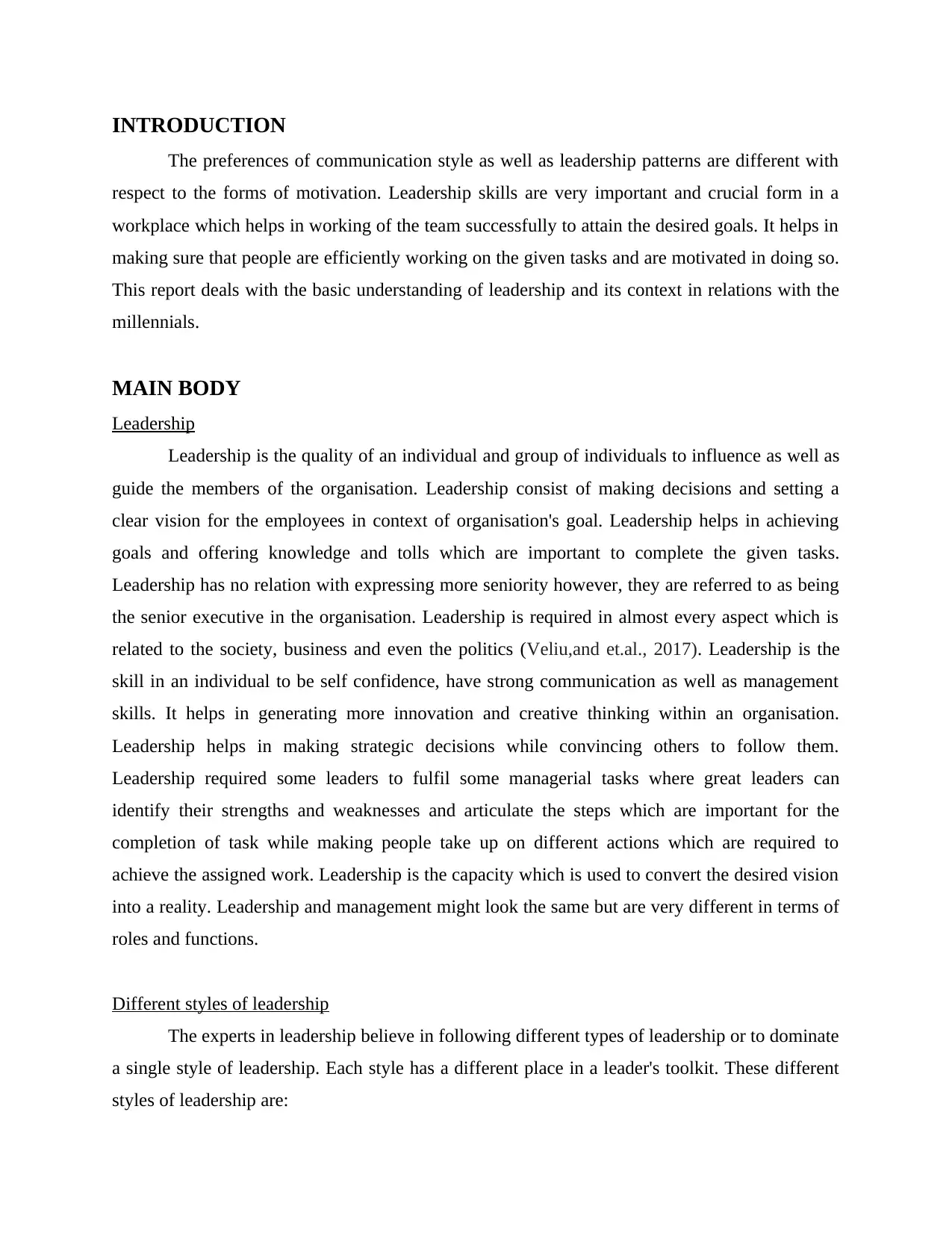
INTRODUCTION
The preferences of communication style as well as leadership patterns are different with
respect to the forms of motivation. Leadership skills are very important and crucial form in a
workplace which helps in working of the team successfully to attain the desired goals. It helps in
making sure that people are efficiently working on the given tasks and are motivated in doing so.
This report deals with the basic understanding of leadership and its context in relations with the
millennials.
MAIN BODY
Leadership
Leadership is the quality of an individual and group of individuals to influence as well as
guide the members of the organisation. Leadership consist of making decisions and setting a
clear vision for the employees in context of organisation's goal. Leadership helps in achieving
goals and offering knowledge and tolls which are important to complete the given tasks.
Leadership has no relation with expressing more seniority however, they are referred to as being
the senior executive in the organisation. Leadership is required in almost every aspect which is
related to the society, business and even the politics (Veliu,and et.al., 2017). Leadership is the
skill in an individual to be self confidence, have strong communication as well as management
skills. It helps in generating more innovation and creative thinking within an organisation.
Leadership helps in making strategic decisions while convincing others to follow them.
Leadership required some leaders to fulfil some managerial tasks where great leaders can
identify their strengths and weaknesses and articulate the steps which are important for the
completion of task while making people take up on different actions which are required to
achieve the assigned work. Leadership is the capacity which is used to convert the desired vision
into a reality. Leadership and management might look the same but are very different in terms of
roles and functions.
Different styles of leadership
The experts in leadership believe in following different types of leadership or to dominate
a single style of leadership. Each style has a different place in a leader's toolkit. These different
styles of leadership are:
The preferences of communication style as well as leadership patterns are different with
respect to the forms of motivation. Leadership skills are very important and crucial form in a
workplace which helps in working of the team successfully to attain the desired goals. It helps in
making sure that people are efficiently working on the given tasks and are motivated in doing so.
This report deals with the basic understanding of leadership and its context in relations with the
millennials.
MAIN BODY
Leadership
Leadership is the quality of an individual and group of individuals to influence as well as
guide the members of the organisation. Leadership consist of making decisions and setting a
clear vision for the employees in context of organisation's goal. Leadership helps in achieving
goals and offering knowledge and tolls which are important to complete the given tasks.
Leadership has no relation with expressing more seniority however, they are referred to as being
the senior executive in the organisation. Leadership is required in almost every aspect which is
related to the society, business and even the politics (Veliu,and et.al., 2017). Leadership is the
skill in an individual to be self confidence, have strong communication as well as management
skills. It helps in generating more innovation and creative thinking within an organisation.
Leadership helps in making strategic decisions while convincing others to follow them.
Leadership required some leaders to fulfil some managerial tasks where great leaders can
identify their strengths and weaknesses and articulate the steps which are important for the
completion of task while making people take up on different actions which are required to
achieve the assigned work. Leadership is the capacity which is used to convert the desired vision
into a reality. Leadership and management might look the same but are very different in terms of
roles and functions.
Different styles of leadership
The experts in leadership believe in following different types of leadership or to dominate
a single style of leadership. Each style has a different place in a leader's toolkit. These different
styles of leadership are:
Paraphrase This Document
Need a fresh take? Get an instant paraphrase of this document with our AI Paraphraser
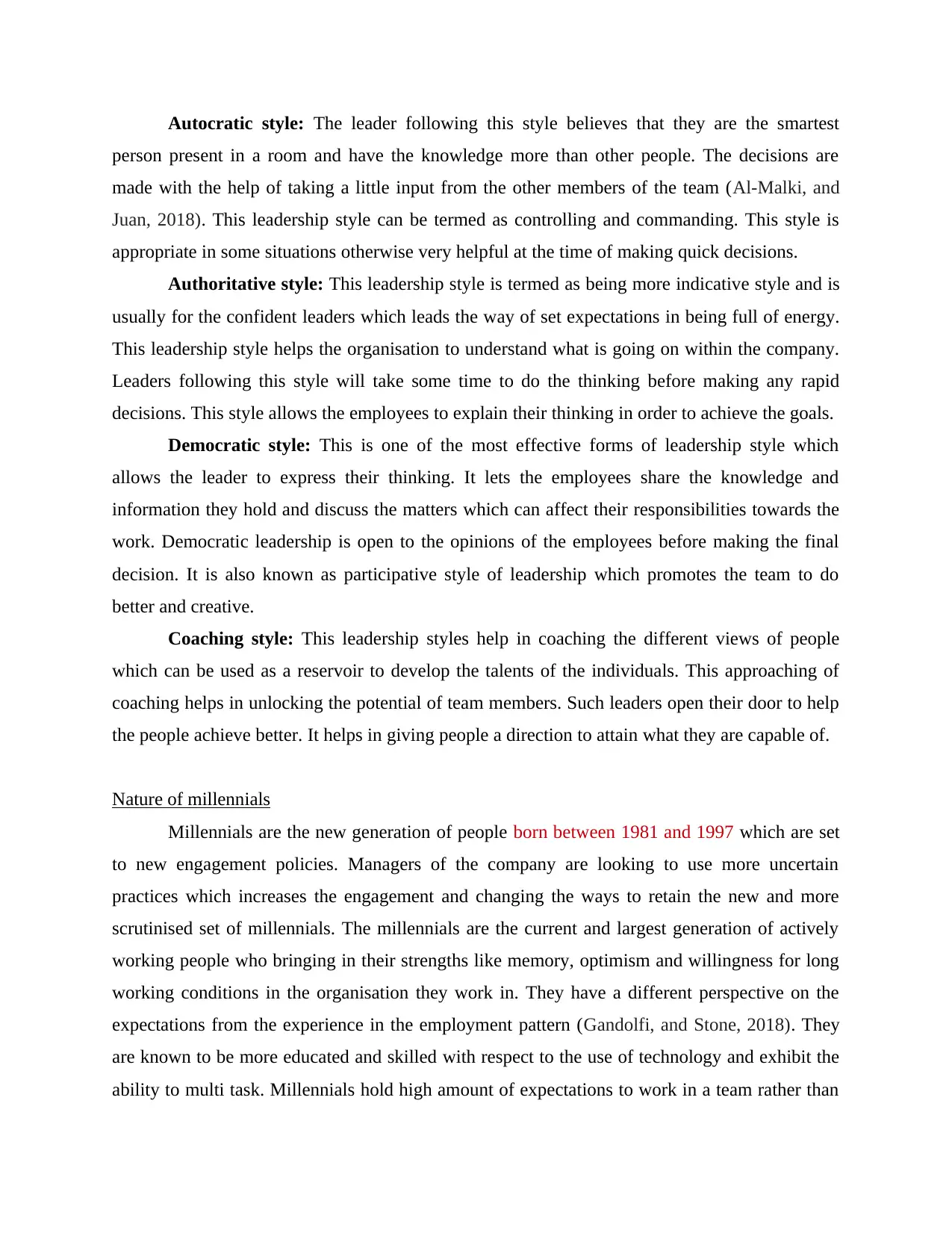
Autocratic style: The leader following this style believes that they are the smartest
person present in a room and have the knowledge more than other people. The decisions are
made with the help of taking a little input from the other members of the team (Al-Malki, and
Juan, 2018). This leadership style can be termed as controlling and commanding. This style is
appropriate in some situations otherwise very helpful at the time of making quick decisions.
Authoritative style: This leadership style is termed as being more indicative style and is
usually for the confident leaders which leads the way of set expectations in being full of energy.
This leadership style helps the organisation to understand what is going on within the company.
Leaders following this style will take some time to do the thinking before making any rapid
decisions. This style allows the employees to explain their thinking in order to achieve the goals.
Democratic style: This is one of the most effective forms of leadership style which
allows the leader to express their thinking. It lets the employees share the knowledge and
information they hold and discuss the matters which can affect their responsibilities towards the
work. Democratic leadership is open to the opinions of the employees before making the final
decision. It is also known as participative style of leadership which promotes the team to do
better and creative.
Coaching style: This leadership styles help in coaching the different views of people
which can be used as a reservoir to develop the talents of the individuals. This approaching of
coaching helps in unlocking the potential of team members. Such leaders open their door to help
the people achieve better. It helps in giving people a direction to attain what they are capable of.
Nature of millennials
Millennials are the new generation of people born between 1981 and 1997 which are set
to new engagement policies. Managers of the company are looking to use more uncertain
practices which increases the engagement and changing the ways to retain the new and more
scrutinised set of millennials. The millennials are the current and largest generation of actively
working people who bringing in their strengths like memory, optimism and willingness for long
working conditions in the organisation they work in. They have a different perspective on the
expectations from the experience in the employment pattern (Gandolfi, and Stone, 2018). They
are known to be more educated and skilled with respect to the use of technology and exhibit the
ability to multi task. Millennials hold high amount of expectations to work in a team rather than
person present in a room and have the knowledge more than other people. The decisions are
made with the help of taking a little input from the other members of the team (Al-Malki, and
Juan, 2018). This leadership style can be termed as controlling and commanding. This style is
appropriate in some situations otherwise very helpful at the time of making quick decisions.
Authoritative style: This leadership style is termed as being more indicative style and is
usually for the confident leaders which leads the way of set expectations in being full of energy.
This leadership style helps the organisation to understand what is going on within the company.
Leaders following this style will take some time to do the thinking before making any rapid
decisions. This style allows the employees to explain their thinking in order to achieve the goals.
Democratic style: This is one of the most effective forms of leadership style which
allows the leader to express their thinking. It lets the employees share the knowledge and
information they hold and discuss the matters which can affect their responsibilities towards the
work. Democratic leadership is open to the opinions of the employees before making the final
decision. It is also known as participative style of leadership which promotes the team to do
better and creative.
Coaching style: This leadership styles help in coaching the different views of people
which can be used as a reservoir to develop the talents of the individuals. This approaching of
coaching helps in unlocking the potential of team members. Such leaders open their door to help
the people achieve better. It helps in giving people a direction to attain what they are capable of.
Nature of millennials
Millennials are the new generation of people born between 1981 and 1997 which are set
to new engagement policies. Managers of the company are looking to use more uncertain
practices which increases the engagement and changing the ways to retain the new and more
scrutinised set of millennials. The millennials are the current and largest generation of actively
working people who bringing in their strengths like memory, optimism and willingness for long
working conditions in the organisation they work in. They have a different perspective on the
expectations from the experience in the employment pattern (Gandolfi, and Stone, 2018). They
are known to be more educated and skilled with respect to the use of technology and exhibit the
ability to multi task. Millennials hold high amount of expectations to work in a team rather than
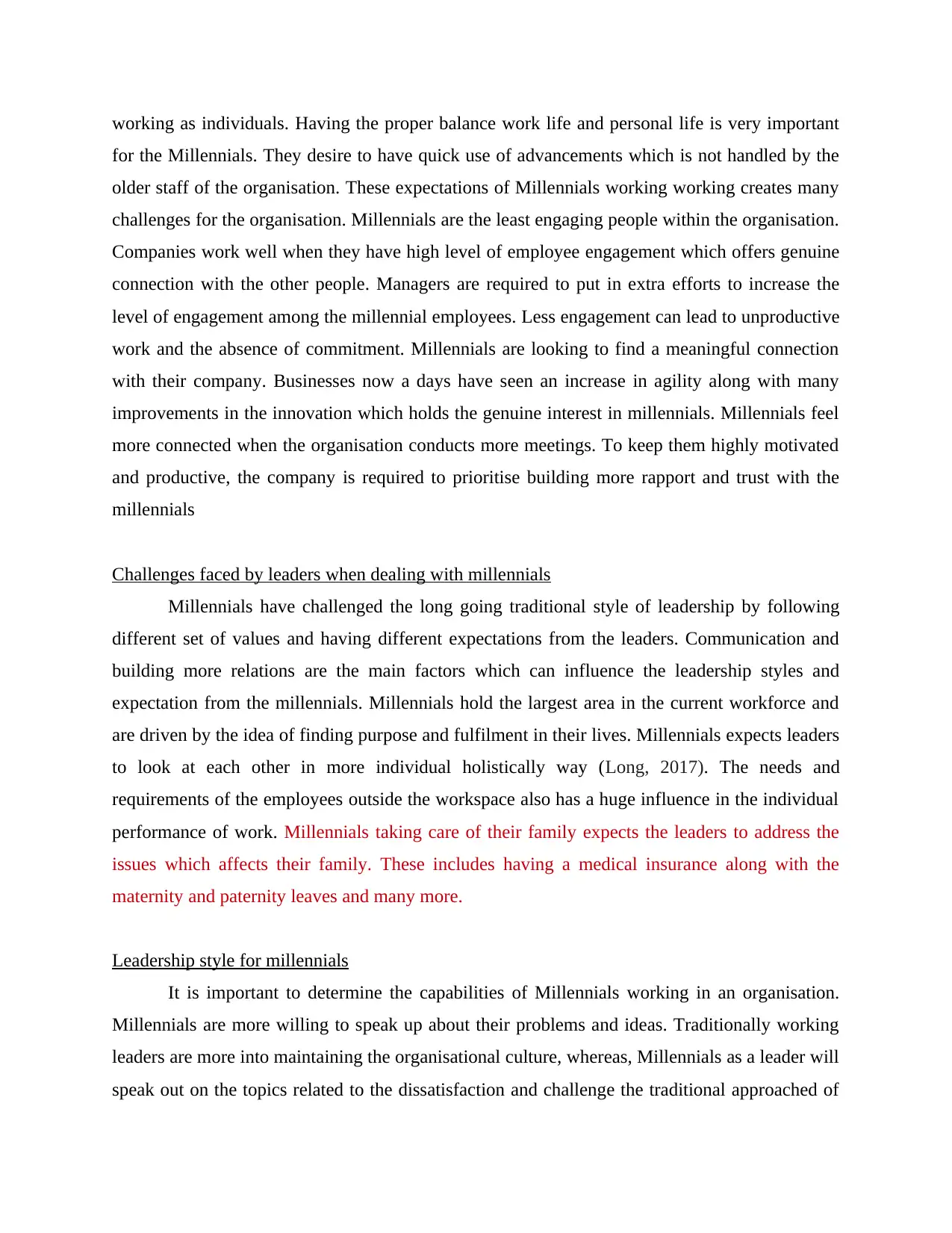
working as individuals. Having the proper balance work life and personal life is very important
for the Millennials. They desire to have quick use of advancements which is not handled by the
older staff of the organisation. These expectations of Millennials working working creates many
challenges for the organisation. Millennials are the least engaging people within the organisation.
Companies work well when they have high level of employee engagement which offers genuine
connection with the other people. Managers are required to put in extra efforts to increase the
level of engagement among the millennial employees. Less engagement can lead to unproductive
work and the absence of commitment. Millennials are looking to find a meaningful connection
with their company. Businesses now a days have seen an increase in agility along with many
improvements in the innovation which holds the genuine interest in millennials. Millennials feel
more connected when the organisation conducts more meetings. To keep them highly motivated
and productive, the company is required to prioritise building more rapport and trust with the
millennials
Challenges faced by leaders when dealing with millennials
Millennials have challenged the long going traditional style of leadership by following
different set of values and having different expectations from the leaders. Communication and
building more relations are the main factors which can influence the leadership styles and
expectation from the millennials. Millennials hold the largest area in the current workforce and
are driven by the idea of finding purpose and fulfilment in their lives. Millennials expects leaders
to look at each other in more individual holistically way (Long, 2017). The needs and
requirements of the employees outside the workspace also has a huge influence in the individual
performance of work. Millennials taking care of their family expects the leaders to address the
issues which affects their family. These includes having a medical insurance along with the
maternity and paternity leaves and many more.
Leadership style for millennials
It is important to determine the capabilities of Millennials working in an organisation.
Millennials are more willing to speak up about their problems and ideas. Traditionally working
leaders are more into maintaining the organisational culture, whereas, Millennials as a leader will
speak out on the topics related to the dissatisfaction and challenge the traditional approached of
for the Millennials. They desire to have quick use of advancements which is not handled by the
older staff of the organisation. These expectations of Millennials working working creates many
challenges for the organisation. Millennials are the least engaging people within the organisation.
Companies work well when they have high level of employee engagement which offers genuine
connection with the other people. Managers are required to put in extra efforts to increase the
level of engagement among the millennial employees. Less engagement can lead to unproductive
work and the absence of commitment. Millennials are looking to find a meaningful connection
with their company. Businesses now a days have seen an increase in agility along with many
improvements in the innovation which holds the genuine interest in millennials. Millennials feel
more connected when the organisation conducts more meetings. To keep them highly motivated
and productive, the company is required to prioritise building more rapport and trust with the
millennials
Challenges faced by leaders when dealing with millennials
Millennials have challenged the long going traditional style of leadership by following
different set of values and having different expectations from the leaders. Communication and
building more relations are the main factors which can influence the leadership styles and
expectation from the millennials. Millennials hold the largest area in the current workforce and
are driven by the idea of finding purpose and fulfilment in their lives. Millennials expects leaders
to look at each other in more individual holistically way (Long, 2017). The needs and
requirements of the employees outside the workspace also has a huge influence in the individual
performance of work. Millennials taking care of their family expects the leaders to address the
issues which affects their family. These includes having a medical insurance along with the
maternity and paternity leaves and many more.
Leadership style for millennials
It is important to determine the capabilities of Millennials working in an organisation.
Millennials are more willing to speak up about their problems and ideas. Traditionally working
leaders are more into maintaining the organisational culture, whereas, Millennials as a leader will
speak out on the topics related to the dissatisfaction and challenge the traditional approached of
⊘ This is a preview!⊘
Do you want full access?
Subscribe today to unlock all pages.

Trusted by 1+ million students worldwide
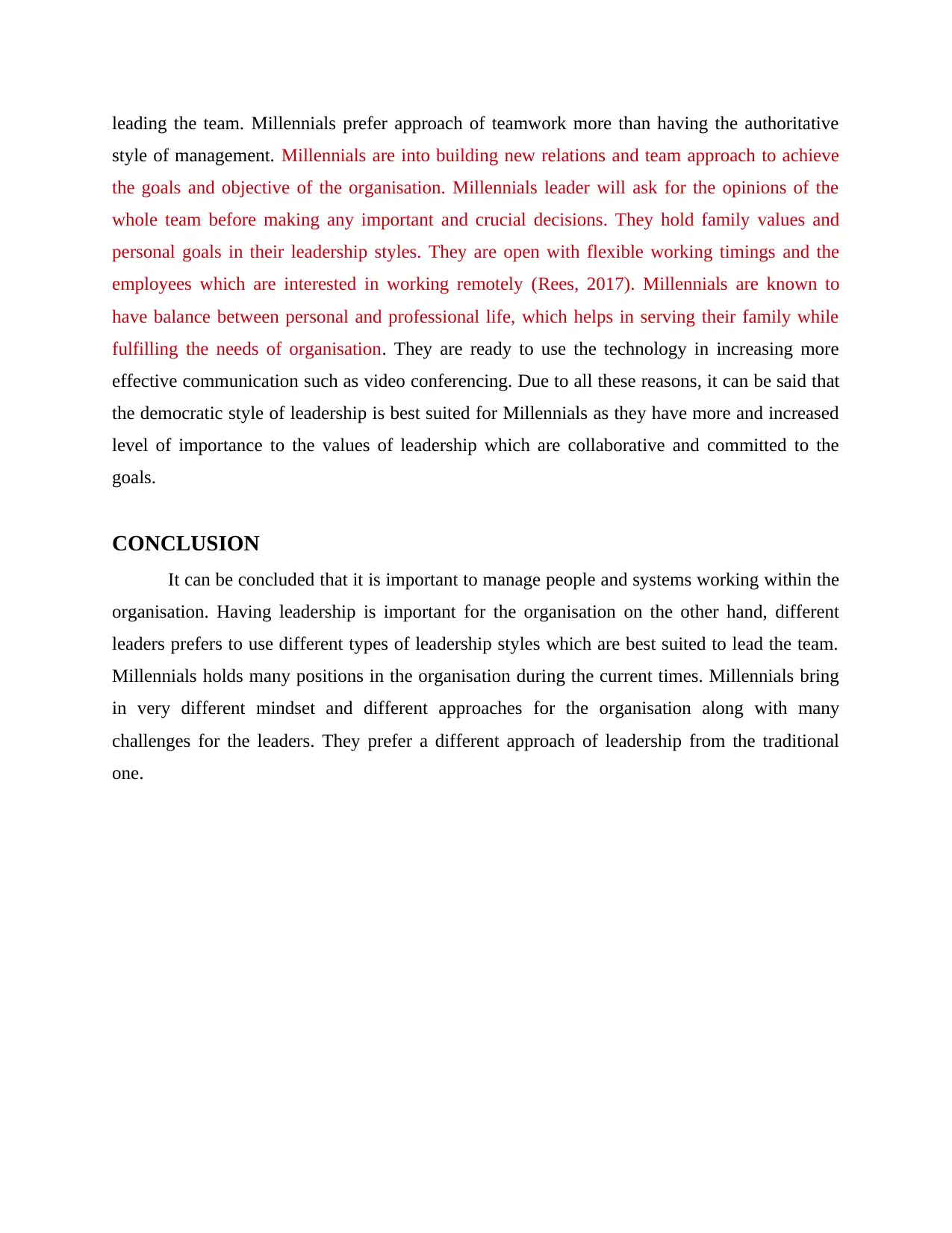
leading the team. Millennials prefer approach of teamwork more than having the authoritative
style of management. Millennials are into building new relations and team approach to achieve
the goals and objective of the organisation. Millennials leader will ask for the opinions of the
whole team before making any important and crucial decisions. They hold family values and
personal goals in their leadership styles. They are open with flexible working timings and the
employees which are interested in working remotely (Rees, 2017). Millennials are known to
have balance between personal and professional life, which helps in serving their family while
fulfilling the needs of organisation. They are ready to use the technology in increasing more
effective communication such as video conferencing. Due to all these reasons, it can be said that
the democratic style of leadership is best suited for Millennials as they have more and increased
level of importance to the values of leadership which are collaborative and committed to the
goals.
CONCLUSION
It can be concluded that it is important to manage people and systems working within the
organisation. Having leadership is important for the organisation on the other hand, different
leaders prefers to use different types of leadership styles which are best suited to lead the team.
Millennials holds many positions in the organisation during the current times. Millennials bring
in very different mindset and different approaches for the organisation along with many
challenges for the leaders. They prefer a different approach of leadership from the traditional
one.
style of management. Millennials are into building new relations and team approach to achieve
the goals and objective of the organisation. Millennials leader will ask for the opinions of the
whole team before making any important and crucial decisions. They hold family values and
personal goals in their leadership styles. They are open with flexible working timings and the
employees which are interested in working remotely (Rees, 2017). Millennials are known to
have balance between personal and professional life, which helps in serving their family while
fulfilling the needs of organisation. They are ready to use the technology in increasing more
effective communication such as video conferencing. Due to all these reasons, it can be said that
the democratic style of leadership is best suited for Millennials as they have more and increased
level of importance to the values of leadership which are collaborative and committed to the
goals.
CONCLUSION
It can be concluded that it is important to manage people and systems working within the
organisation. Having leadership is important for the organisation on the other hand, different
leaders prefers to use different types of leadership styles which are best suited to lead the team.
Millennials holds many positions in the organisation during the current times. Millennials bring
in very different mindset and different approaches for the organisation along with many
challenges for the leaders. They prefer a different approach of leadership from the traditional
one.
Paraphrase This Document
Need a fresh take? Get an instant paraphrase of this document with our AI Paraphraser

REFERENCES
Books and Journals
Al-Malki, M. and Juan, W., (2018). Leadership styles and job performance: A literature review.
Journal of International Business Research and Marketing. 3(3).
Gandolfi, F. and Stone, S., (2018). Leadership, leadership styles, and servant leadership. Journal
of Management Research. 18(4). pp.261-269.
Long, S., (2017). Exploring which leadership styles are effective with millennial employees.
Rees, T., (2017). An investigation on how different leadership styles affect the management of
millennials (Doctoral dissertation, Cardiff Metropolitan University).
Veliu,and et.al., (2017). THE INFLUENCE OF LEADERSHIP STYLES ON EMPLOYEE'S
PERFORMANCE. Management (16487974). 31(2).
Books and Journals
Al-Malki, M. and Juan, W., (2018). Leadership styles and job performance: A literature review.
Journal of International Business Research and Marketing. 3(3).
Gandolfi, F. and Stone, S., (2018). Leadership, leadership styles, and servant leadership. Journal
of Management Research. 18(4). pp.261-269.
Long, S., (2017). Exploring which leadership styles are effective with millennial employees.
Rees, T., (2017). An investigation on how different leadership styles affect the management of
millennials (Doctoral dissertation, Cardiff Metropolitan University).
Veliu,and et.al., (2017). THE INFLUENCE OF LEADERSHIP STYLES ON EMPLOYEE'S
PERFORMANCE. Management (16487974). 31(2).
1 out of 8
Related Documents
Your All-in-One AI-Powered Toolkit for Academic Success.
+13062052269
info@desklib.com
Available 24*7 on WhatsApp / Email
![[object Object]](/_next/static/media/star-bottom.7253800d.svg)
Unlock your academic potential
Copyright © 2020–2025 A2Z Services. All Rights Reserved. Developed and managed by ZUCOL.





